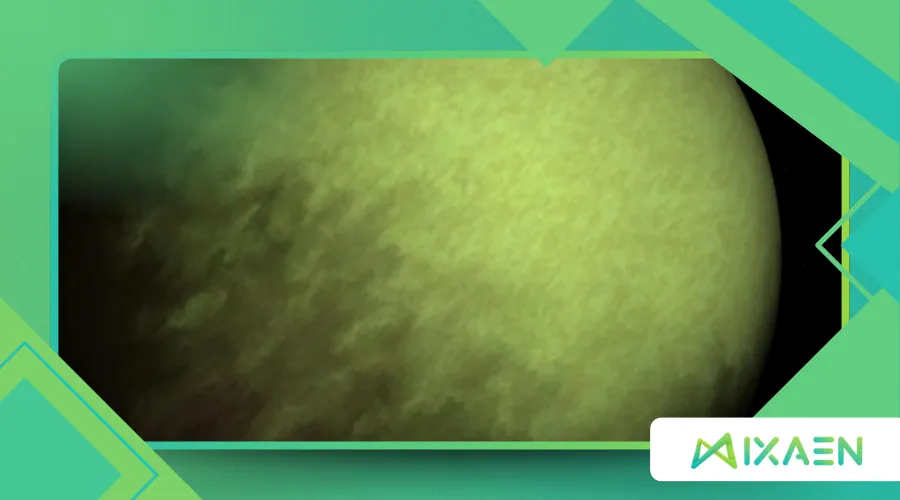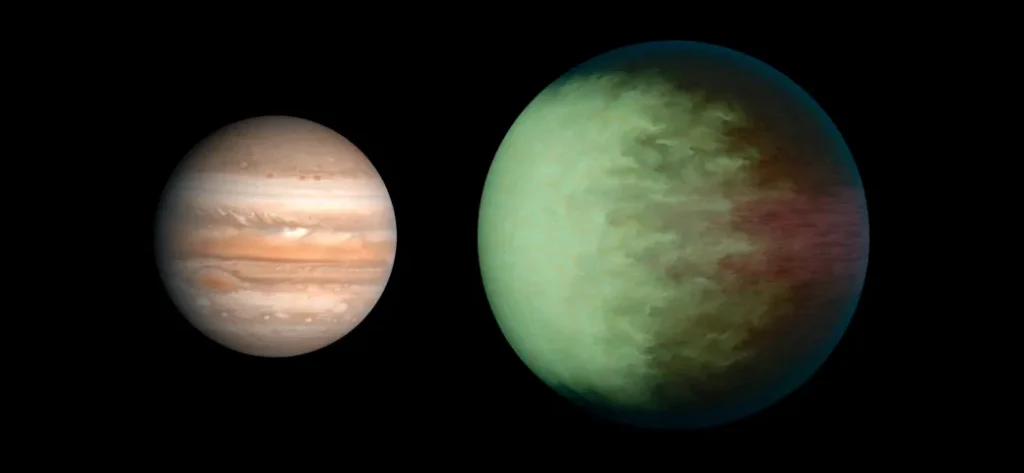Kepler-7b: The Most Reflective Gas Planet Ever Discovered

Kepler-7b, a gas giant 3,000 light-years away, holds the title of the most reflective exoplanet known to science.
Anúncios
Its shimmering clouds, possibly forged from silicates or iron, capture and scatter light in ways that challenge our understanding of planetary atmospheres.
This hot Jupiter, orbiting its star in a mere five days, isn’t just a spectacle—it’s a puzzle that astronomers are still piecing together.
Why does this planet shine so brightly?
Let’s dive into the science, the surprises, and the implications of this celestial marvel.
The discovery of Kepler-7b not only enhances our knowledge of exoplanets but also raises questions about the formation and evolution of gas giants across the universe.
A Cosmic Mirror in the Sky
Picture a planet that floats like Styrofoam, its density so low it could bob in a cosmic bathtub.
Kepler-7b, discovered in 2009 by NASA’s Kepler spacecraft, is a gas giant 1.5 times Jupiter’s size but only half its mass.
This puffiness, combined with its scorching proximity to its G-type star, makes it a standout among exoplanets.
Unlike most hot Jupiters, which absorb light and emit heat in the infrared, this world reflects an astonishing amount of visible light, boasting an albedo of 0.32.
For context, Jupiter’s albedo is around 0.34, but Kepler-7b achieves this despite temperatures exceeding 1,500°F (815°C).
The planet’s reflectivity stems from its unique cloud structure.
Data from NASA’s Kepler and Spitzer telescopes, analyzed in a 2013 study by Brice-Olivier Demory, revealed a lopsided cloud distribution.
The western hemisphere is blanketed in dense clouds, reflecting starlight, while the eastern side remains clearer.
These clouds, potentially composed of rock or iron particles, thrive in the planet’s low-gravity, high-altitude atmosphere.
This discovery marked a milestone: Kepler-7b became the first exoplanet with a mapped cloud system, offering a glimpse into alien weather patterns.
The unique characteristics of Kepler-7b challenge existing theories about gas giants and their atmospheres, prompting further research into atmospheric dynamics.
Characteristic Comparison
| Characteristic | Kepler-7b | Jupiter |
|---|---|---|
| Mass | 0.441 Jupiter | 1 Jupiter |
| Radius | 1.5 Jupiter | 1 Jupiter |
| Albedo | 0.32 | 0.34 |
| Orbital Period | 4.9 days | 11.86 years |
+ Historic Discovery: Scientists Detect Exoplanets in the Andromeda Galaxy
The Science Behind the Shine
What makes a planet gleam like a polished gem?
For Kepler-7b, it’s all about atmospheric chemistry and physics.
Hot Jupiters typically absorb light due to molecules like sodium or titanium monoxide, but this planet may lack these absorbers.
Demory’s team suggested that Kepler-7b’s atmosphere could have 10 to 100 times less sodium and potassium than expected, allowing clouds to dominate the reflective landscape.
These clouds, unlike Earth’s water vapor, might be silicate-based, condensing at the extreme temperatures of a planet orbiting just 0.06 AU from its star.
The planet’s tidally locked orbit adds intrigue.
One side bakes under constant starlight, while the other lingers in perpetual darkness.
Yet, Spitzer’s infrared observations show that heat circulates, warming the nightside.
This suggests powerful atmospheric currents, driven by the stark temperature contrast, which stabilize the cloud deck.
The result is a planet that not only reflects light but also redistributes energy in ways that defy simple models.
This dynamic system challenges astronomers to rethink how gas giants behave under extreme conditions.
Understanding these mechanisms is critical for developing models that can predict the behavior of other exoplanets in similar environments.
Consider a hypothetical alien observer on a distant moon, gazing at Kepler-7b.
They’d see a crescent of light, waxing and waning as the planet orbits, its western clouds catching the star’s glow like a lighthouse beacon.
This visual spectacle underscores the planet’s uniqueness—no other known exoplanet matches its reflective prowess.
A Statistical Spotlight
To grasp Kepler-7b’s rarity, consider this: among the 5,800+ exoplanets confirmed by 2025, fewer than 1% have had their albedo measured.
Kepler-7b stands out not just for its reflectivity but for the precision of its data.
The 2013 study, published in Astrophysical Journal Letters, revised its albedo from an initial 0.38 to 0.32, a testament to the rigor of combining Kepler’s visible-light data with Spitzer’s infrared measurements.
This precision anchors our understanding of hot Jupiter atmospheres, making Kepler-7b a benchmark for future studies.
The meticulous nature of this research highlights the importance of collaboration in the scientific community to achieve accurate results.
| Exoplanet | Albedo | Year Measured |
|---|---|---|
| Kepler-7b | 0.32 | 2013 |
| HD 189733b | >0.4 | 2011 |
| υ And b | 0.42 | 2002 |

Beyond the Clouds: Implications for Exoplanet Science
The discovery of Kepler-7b’s reflectivity reshapes how we study exoplanets.
Traditional models assumed hot Jupiters were dark, absorbing most light due to their intense heat.
This planet’s brightness forces a recalibration of those assumptions.
If clouds can dominate an atmosphere at 1,500°F, what other surprises lurk in the galaxy’s billions of exoplanets?
The planet’s low density and reflective clouds suggest a formation history distinct from Jupiter’s, possibly involving less heavy-element enrichment or unique migration patterns.
This gas giant also informs the search for habitable worlds.
Techniques developed to map its clouds—combining transit photometry with infrared spectroscopy—can be adapted to study smaller, rocky planets.
Imagine applying these methods to a super-Earth in a star’s habitable zone, probing for water vapor or biosignatures.
Kepler-7b, though inhospitable, paves the way for such discoveries by refining our tools and challenging our biases.
The implications of Kepler-7b extend beyond its own characteristics, influencing the search for life beyond our solar system.
Take, for example, a future mission scanning a distant exoplanet’s atmosphere.
Scientists might detect a reflective signature, reminiscent of Kepler-7b, and deduce the presence of silicate clouds.
This could hint at a planet’s geological activity, even if it’s a gas giant.
Such insights bridge the gap between gas giants and terrestrial worlds, enriching our cosmic perspective.
++ What Would It Be Like to Live on Jupiter in the Future? Imagine a City in the Clouds
A Reflective Analogy
Think of Kepler-7b as a disco ball in the cosmos.
Just as a disco ball scatters light across a dance floor, this planet’s clouds scatter starlight, creating a dazzling display.
But unlike a static decoration, Kepler-7b is alive with atmospheric currents, its clouds shifting in a delicate balance of heat and gravity.
This analogy captures its dynamic nature—a world that doesn’t just shine but performs, its reflectivity a choreography of physics and chemistry.
Such analogies help convey complex astronomical concepts in a relatable way, enhancing public interest in space science.

Challenges and Future Frontiers
Studying Kepler-7b isn’t without hurdles.
Its distance—3,000 light-years—limits direct imaging, and its intense heat complicates spectroscopic analysis.
Current telescopes struggle to resolve the fine details of its cloud composition.
The James Webb Space Telescope, operational in 2025, offers hope, with its ability to probe infrared wavelengths and detect molecular signatures.
Could it confirm the presence of silicate clouds or reveal new atmospheric components?
Future missions, like the proposed LUVOIR, might even capture reflected light spectra, unlocking the planet’s chemical secrets.
Another challenge is contextualizing Kepler-7b’s uniqueness.
Are reflective hot Jupiters common, or is this planet an outlier?
Surveys of other exoplanets, like those conducted by Kepler’s K2 mission, suggest that high-albedo gas giants are rare.
Yet, each new discovery refines our understanding, building a mosaic of planetary diversity.
Kepler-7b’s data, archived in the Mikulski Archive for Space Telescopes (MAST), remains a treasure trove for researchers, fueling studies years after its initial discovery.
Addressing these challenges will require advancements in technology and international collaboration among astronomers.
For more information on exoplanets, visit NASA’s Exoplanet Exploration.
Engaging the Cosmic Imagination
What does Kepler-7b’s brilliance tell us about our place in the universe?
This planet, with its mirror-like clouds, reminds us that the cosmos is full of surprises.
It challenges our assumptions, from the darkness of hot Jupiters to the stability of alien atmospheres.
Its discovery, rooted in the ingenuity of NASA’s Kepler mission, underscores the power of human curiosity.
By mapping its clouds, we’ve taken a step toward understanding not just gas giants but the myriad worlds that orbit distant stars.
Kepler-7b’s story is more than a scientific triumph—it’s a call to wonder.
It invites us to imagine alien skies, where clouds of rock and iron gleam under a blazing star.
As we refine our telescopes and theories, this reflective giant will continue to guide us, a beacon in the vast expanse of the Milky Way.
The ongoing exploration of exoplanets like Kepler-7b fuels our imagination and drives scientific inquiry into the unknown.
